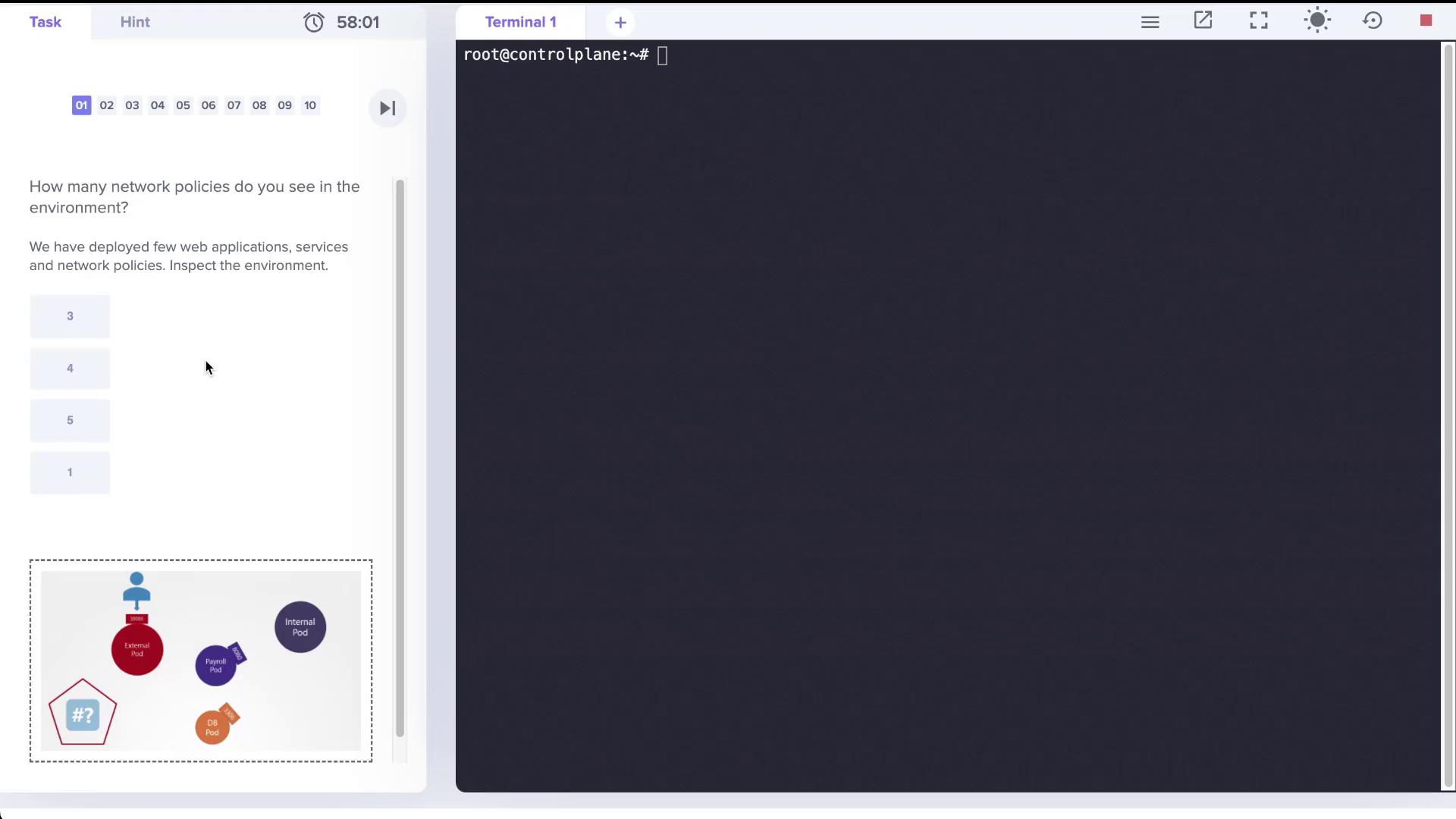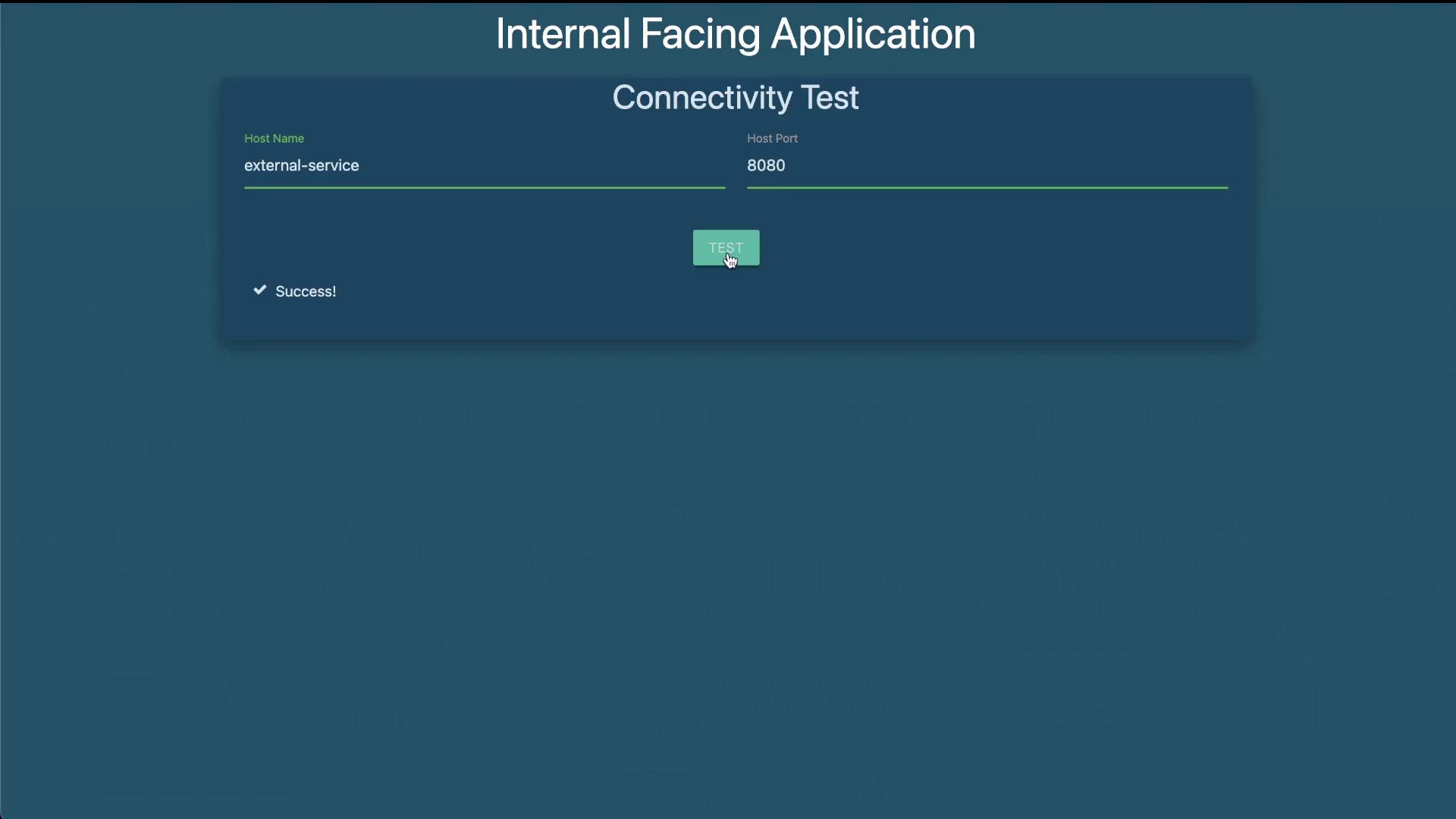Certified Kubernetes Application Developer - CKAD
Services Networking
Solution Network Policies optional
In this lesson, we explore a practice test on network policies in a Kubernetes cluster. The exercise involves inspecting deployed web applications, services, and network policies to understand how traffic is controlled within the environment.

The exercise begins with the question: “How many network policies do you see in the environment?” In our setup, several web applications and services have been deployed, and a specific network policy is defined to control traffic to one of the pods. Let's walk through the environment.
Inspecting the Pods and Services
Start by checking the list of running pods with:
root@controlplane:~# k get pods
NAME READY STATUS RESTARTS AGE
external 1/1 Running 0 2m20s
internal 1/1 Running 0 2m19s
mysql 1/1 Running 0 2m19s
payroll 1/1 Running 0 2m19s
Next, view the services available in the cluster:
root@controlplane:~# k get service
NAME TYPE CLUSTER-IP EXTERNAL-IP PORT(S) AGE
db-service ClusterIP 10.109.89.42 <none> 3306/TCP 2m42s
external-service NodePort 10.108.170.44 <none> 8080:30080/TCP 2m42s
internal-service NodePort 10.98.11.243 <none> 8080:30082/TCP 2m42s
kubernetes ClusterIP 10.96.0.1 <none> 443/TCP 39m
payroll-service NodePort 10.110.165.31 <none> 8080:30083/TCP 2m42s
Note
Here, notice that the payroll service is exposed on port 8080, the database service on port 3306, and both the external and internal services are available on port 8080.
Checking the Network Policies
When you list network policies using the following command:
root@controlplane:~# k get networkpolicies
error: the server doesn't have a resource type "networkpolicies"
You see an error because the short alias is not recognized. Using the short form, however, produces the expected result:
root@controlplane:~# k get netpol
NAME POD-SELECTOR AGE
payroll-policy name=payroll 3m31s
This output confirms that there is one network policy named payroll-policy, which applies to pods with the label name=payroll.
Reviewing the Network Policy Details
Examine the details of the network policy with:
root@controlplane:~# k describe netpol payroll-policy
Name: payroll-policy
Namespace: default
Created on: 2022-04-18 20:35:54 +0000 UTC
Labels: <none>
Annotations: <none>
Spec:
PodSelector: name=payroll
Allowing ingress traffic:
To Port: 8080/TCP
From:
PodSelector: name=internal
Not affecting egress traffic
Policy Types: Ingress
This policy allows ingress traffic on TCP port 8080 to the payroll pod only if the traffic originates from pods with the label name=internal. Since no egress rules are defined, the payroll pod continues to allow all outgoing traffic.
Understanding the Impact of the Network Policy
By default, all pods allow both ingress and egress traffic. Once a network policy is applied, only the traffic permitted by the policy is allowed. In this scenario:
- Only ingress traffic from the internal pod on TCP port 8080 is allowed to reach the payroll pod.
- All egress traffic from the payroll pod remains unrestricted.
- Pods or sources without the label
name=internalcannot access the payroll pod on port 8080.
Connectivity tests revealed that:
- The internal-facing application successfully connected to the payroll service on port 8080.
- The external-facing application timed out when attempting to access the payroll service, confirming that the policy is working as intended.

Creating a Custom Network Policy
The lab exercise also requires creating a new network policy to allow traffic exclusively from the internal application to both the payroll and database (MySQL) services. This policy will restrict egress traffic from the internal pod so that it only communicates with the payroll pod on TCP port 8080 and the MySQL pod on TCP port 3306.
Below is a sample YAML specification for this custom network policy. Save it as internal-policy.yaml:
apiVersion: networking.k8s.io/v1
kind: NetworkPolicy
metadata:
name: internal-policy
namespace: default
spec:
podSelector:
matchLabels:
name: internal
policyTypes:
- Egress
egress:
- to:
podSelector:
matchLabels:
name: payroll
ports:
- protocol: TCP
port: 8080
- to:
podSelector:
matchLabels:
name: mysql
ports:
- protocol: TCP
port: 3306
Key Points
This policy selects the internal pod (using the label name: internal) and applies an egress rule that allows traffic:
- To the payroll pod on TCP port 8080.
- To the MySQL pod on TCP port 3306.
To create the policy, run:
root@controlplane:~# k create -f internal-policy.yaml
networkpolicy.networking.k8s.io/internal-policy created
Verify the new policy details with:
root@controlplane:~# k describe netpol internal-policy
Name: internal-policy
Namespace: default
Created on: 2022-04-18 20:53:13 +0000 UTC
Labels: <none>
Annotations: <none>
Spec:
PodSelector: name=internal
Not affecting ingress traffic
Allowing egress traffic:
To:
PodSelector: name=payroll
Ports: 8080/TCP
To:
PodSelector: name=mysql
Ports: 3306/TCP
Policy Types: Egress
This confirms that the internal pod is now restricted to sending traffic only to the payroll service on port 8080 and the MySQL service on port 3306.
Final Connectivity Testing
After applying these policies:
- The internal-facing application should be able to access both the payroll and database services.
- The external-facing application or any other source will be unable to access the payroll pod on port 8080.
This completes our lab exercise on network policies, demonstrating how to control ingress and egress traffic within a Kubernetes environment effectively.
For further information on Kubernetes network policies, consider exploring the Kubernetes Documentation.
Watch Video
Watch video content